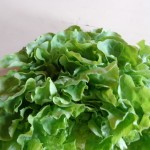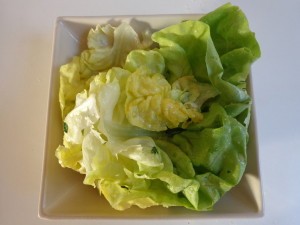Green salad, French style
This is the classic French salad, the one that invariably appeared whenever you wandered into a bistro and ordered une salade. It consists simply of lettuce and dressing – no cucumbers, tomatoes, radishes or other embellishments. It doesn’t need them. For it is perfection in its simplicity – light and packed with flavor.
 The lettuce most often used in France is what Americans call Boston lettuce, and what the French call simply salade (at right). Another favorite is escarole, scarole in French.
The lettuce most often used in France is what Americans call Boston lettuce, and what the French call simply salade (at right). Another favorite is escarole, scarole in French.
 Rarely were other types of lettuce used in the old days, but now one may encounter innovations like feuille de chêne, literally oak-leaf, a variety of lettuce with scalloped leaves (at left).
Rarely were other types of lettuce used in the old days, but now one may encounter innovations like feuille de chêne, literally oak-leaf, a variety of lettuce with scalloped leaves (at left).
As for the dressing, in previous times salade verte was always served with vinaigrette à la moutarde – a vinaigrette of Dijon mustard, red wine vinegar, sunflower or peanut oil, salt, pepper and shallot or garlic. In Paris, at least. In southern France, olive oil was used, sometimes with lemon instead of vinegar. Now there are variations throughout the country, with balsamic vinegar and other upstarts making an occasional appearance.
The tragedy today is that it’s next to impossible to find a classic salade verte in a French bistro. The lettuce may be the same, but bottled dressings have largely replaced the homemade vinaigrettes that gave this salad such distinction. The newfangled sauce is runny, white and – perish the thought – can be sweet.
All lovers of French food must fight this trend by making their own vinaigrette. It takes about two minutes and results in a thick sauce that clings to the lettuce leaves, imbuing each bite with bursts of delicious flavor, smooth with just a touch of tanginess. I like to snip fresh herbs on top – not just parsley, which is classic, but also basil, chives, cilantro, dill or mint. Experiment to see what you prefer. Then sit back and enjoy a perfect salad.
1 head Boston lettuce
2 tsp. Dijon mustard
1 tsp. red wine vinegar
1/4 tsp. salt
3 tbsp. sunflower oil, peanut oil or another vegetable oil
1 shallot or 1 clove garlic, peeled and finely minced
freshly ground black pepper
1 tbsp. fresh herbs, snipped: parsley, basil, chives, cilantro, dill, mint or a combination
Remove the core of the lettuce. Separate the leaves. Remove the basket from your salad spinner, fill the bottom with cool water and immerse the leaves to wash them. Place the clean leaves in the basket and spin dry. Tear the larger leaves in half.
In the bottom of a large salad bowl, combine the mustard and vinegar. Add the salt and stir. Add one tablespoon oil and stir vigorously until all the oil has been incorporated by the mustard – it should make a thick emulsion. Repeat with the second tablespoon of oil, and then the third. You should now have a thick sauce that resembles homemade mayonnaise in its consistency. (For a video demonstration, click here.)
Add the minced shallot or garlic. Grind in some pepper.
Place the dry lettuce leaves on top of the sauce. Sprinkle with the herbs.
Just before serving, toss the salad by lifting from the bottom and folding over several times to coat all the leaves evenly with the sauce. Serves 3-4.






Simplicity itself. Used 3 kinds of soft lettuces, combination canola and evoo, tiniest bit of minced garlic. Parsley. Served after a bowl of steaming mussels. Definitely a keeper. Looking forward to trying some minor variations.
Hi Fran. So glad you like the salad! There are many possible variations. One I use often is to substitute lemon juice for the vinegar. Happy cooking!
Made the subversive version of this. Super. Love the idea of trying all of the various combinations of garlic/shallot, herb mixtures.
Thanks,
Joe
Hi Joe. Love it that this salad has somehow acquired a subversive version. Glad you enjoyed it. Happy cooking!
Pingback: Teaspoon Vinaigrette + Simple Green Salad - Vegancyclopedia
Hi EFC, I am a first time visitor to your site, arrived via Bruno Chief of Police. I lived for a few months at 12, rue Monge in 1970, by Place Maubert. I tried to sell magazines like “Evergreen,” now long gone, which even the French police could see were subversive and I almost got arrested. I’ve always wanted to learn to make a vinaigrette, now is my chance. My question: You give two versions of how to add garlic – either mince it (per the printed version) or cut cloves in half, leave for 10 minutes, then remove (per the video). Thanks! Richard
Richard, welcome to EFC. So to answer your question, how to add the garlic depends on how subversive you want to be. For a subtler flavor, cut the clove in two and let it sit in the sauce for a while, then remove. For a subversively powerful salad, mince it and leave it in. I’ve done this many times and never got arrested. Why not try both methods and see which you prefer? Cheers, Meg
Oh. Wow! I just made this for a super easy, but amazingly delicious dinner. Lamb chops, green beans with almonds, a baked potato. And ended with this amazing salad! Thank you!
I have to say, this was the exact salad I’ve been hunting for, for years. The combination of the flavorful dressing, light lettuce, and fresh herbs is intoxicating. I have made this every night for the past month, and have enjoyed experimenting with garlic, versus shallots and garlic, versus other vinegars…..but I always come back to the simplest, just as you intend. Superb!!!!! And I have shared and shared and shared, and all agree!
Hal, thank you. I’ve been writing this blog for nearly eight years with no compensation other than the occasional comment from readers. I live for feedback like yours. Happy cooking!
want to try this tonight but its a make ahead and take salad. would you still suggest mixing the dressing in the salad bowl? add lettuce in advance or wait until i’m at the party and ready to serve?
Hello Gerri. The best plan would be to mix up the sauce (including the garlic) and take it to the party in a jar. You can mix it with the lettuce when you get there, preferably just before serving!
Thank you so much for this recipe!! I used it yesterday for my husband’s birthday diner and it was an absolute succes, everybody loved it, adults and children. It will go into our family-recipe book!
Ah! The absolute classic! Merci, Meg for posting the vinagarette recipe! I’ve been using so-called classic dressing recipes found online and they just don’t come close to what I remember when I lived in Paris back in 1976! (Oh, how I miss Her!) I made this last night with just butter lettuce and escarole and my husband went nuts! So guess what is on the menu again for tonite with pan roasted cod? Thank you SO much once again, mon chere!
Great to hear you like it, and many thanks for the feedback! This way of preparing vinaigrette was taught to me by a Frenchman many years ago, and I make it all the time. Definitely a crowd pleaser…
Thinks for this recipe.
I am on vacation in the Provence right now… and here the olive oil from the small stalls from the local farmers at the markets is something else.
Slightly opaque and pressed cold, from the harvest at the end of 2016, it makes a highly delicious dressing along with the other ingredients you mention with an oak leaf lettuce.
I didn’t know that peanut oil was ever popular in France. Weren’t walnut and hazelnut oils ever used on salad? And is the sunflower oil used today refined? I like unrefined sunflower oil–we buy it at Russian markets here–but it has a very strong flavor.
Oak leaf lettuce is popular among home gardeners here, but I think it may be a different variety from the one in your picture. My heads are always very loose.
Interesting comment, Linda. Thanks. In fact peanut oil — huile d’arachide — was the main kind of cooking oil used here when I arrived in the 1970s, at least that’s my recollection, and it’s still widely used. How widely I don’t know — I will do a little research into this. The sunflower oil sold in supermarkets is refined, but I’m sure it’s possible to get the unrefined variety in the growing number of organic shops around Paris. As for walnut and hazelnut oils, they are used more in southwest France than up here in the north. They add a delightful touch to salads, and I use them frequently.